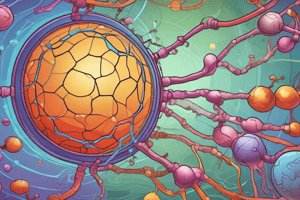Podcast
Questions and Answers
What is the primary goal of cellular respiration?
What is the primary goal of cellular respiration?
- To store energy in carbohydrates
- To break down water molecules
- To produce ATP (correct)
- To transform potential energy into kinetic energy
Which type of metabolism utilizes molecular oxygen as the final electron acceptor?
Which type of metabolism utilizes molecular oxygen as the final electron acceptor?
- Aerobic metabolism (correct)
- Anaerobic metabolism
- Fermentative metabolism
- Photosynthetic metabolism
During which process is a significant amount of ATP produced?
During which process is a significant amount of ATP produced?
- Oxidation of food molecules (correct)
- Digestion
- Glycolysis
- Energy investment phase
What happens to glucose during aerobic respiration?
What happens to glucose during aerobic respiration?
What is produced during glycolysis per glucose molecule?
What is produced during glycolysis per glucose molecule?
What is one advantage of aerobic metabolism compared to anaerobic metabolism?
What is one advantage of aerobic metabolism compared to anaerobic metabolism?
What type of energy is stored in chemical bonds?
What type of energy is stored in chemical bonds?
Which potential electron acceptor can be used in anaerobic respiration?
Which potential electron acceptor can be used in anaerobic respiration?
Which statement about glycolysis is true?
Which statement about glycolysis is true?
What is the first step that occurs when oxygen is available after glycolysis?
What is the first step that occurs when oxygen is available after glycolysis?
In the Krebs cycle, how many CO2 molecules are produced from one Acetyl-CoA?
In the Krebs cycle, how many CO2 molecules are produced from one Acetyl-CoA?
What type of organisms primarily use aerobic respiration?
What type of organisms primarily use aerobic respiration?
What kind of energy transformation occurs during cellular metabolism?
What kind of energy transformation occurs during cellular metabolism?
What does NADH do during cellular respiration?
What does NADH do during cellular respiration?
Where does the Krebs cycle take place?
Where does the Krebs cycle take place?
How does anaerobic metabolism differ in energy yield compared to aerobic metabolism?
How does anaerobic metabolism differ in energy yield compared to aerobic metabolism?
How many NADH molecules are produced from each turn of the Krebs cycle?
How many NADH molecules are produced from each turn of the Krebs cycle?
What happens in the downhill portion of glycolysis?
What happens in the downhill portion of glycolysis?
Where does the Krebs cycle take place within the cell?
Where does the Krebs cycle take place within the cell?
What is the main purpose of chemiosmosis in cellular respiration?
What is the main purpose of chemiosmosis in cellular respiration?
What is the net number of ATPs produced during glycolysis after accounting for ATP used?
What is the net number of ATPs produced during glycolysis after accounting for ATP used?
What molecule is formed when pyruvate loses a carbon during its conversion to Acetyl-CoA?
What molecule is formed when pyruvate loses a carbon during its conversion to Acetyl-CoA?
How many ATP molecules are generated when NADH activates pumps in the electron transport chain?
How many ATP molecules are generated when NADH activates pumps in the electron transport chain?
What product is formed during alcoholic fermentation?
What product is formed during alcoholic fermentation?
Which of the following statements about the metabolism of lipids is true?
Which of the following statements about the metabolism of lipids is true?
What happens to excess proteins during metabolism?
What happens to excess proteins during metabolism?
What regulates the rate of cellular respiration when ATP levels are sufficient?
What regulates the rate of cellular respiration when ATP levels are sufficient?
Which process is used to reset NAD+ in the absence of oxygen?
Which process is used to reset NAD+ in the absence of oxygen?
What total ATP yield can be obtained from one triglyceride molecule?
What total ATP yield can be obtained from one triglyceride molecule?
What is produced from pyruvate during lactic acid fermentation?
What is produced from pyruvate during lactic acid fermentation?
Flashcards
Cellular Metabolism
Cellular Metabolism
All chemical processes occurring within living cells, including energy production and utilization.
Kinetic Energy
Kinetic Energy
The energy of motion.
Potential Energy
Potential Energy
Stored energy.
Chemical Energy
Chemical Energy
Signup and view all the flashcards
Cellular Respiration
Cellular Respiration
Signup and view all the flashcards
Aerobes
Aerobes
Signup and view all the flashcards
Anaerobes
Anaerobes
Signup and view all the flashcards
Glycolysis
Glycolysis
Signup and view all the flashcards
Oxidation
Oxidation
Signup and view all the flashcards
Electron Transport Chain
Electron Transport Chain
Signup and view all the flashcards
Chemiosmosis
Chemiosmosis
Signup and view all the flashcards
Oxidative Phosphorylation
Oxidative Phosphorylation
Signup and view all the flashcards
Lactate Fermentation
Lactate Fermentation
Signup and view all the flashcards
Alcoholic Fermentation
Alcoholic Fermentation
Signup and view all the flashcards
Lipid Metabolism
Lipid Metabolism
Signup and view all the flashcards
Protein Metabolism
Protein Metabolism
Signup and view all the flashcards
Deamination
Deamination
Signup and view all the flashcards
Cellular Respiration Regulation
Cellular Respiration Regulation
Signup and view all the flashcards
Allosteric Site
Allosteric Site
Signup and view all the flashcards
Anaerobic Respiration
Anaerobic Respiration
Signup and view all the flashcards
Uphill Portion of Glycolysis
Uphill Portion of Glycolysis
Signup and view all the flashcards
Downhill Portion of Glycolysis
Downhill Portion of Glycolysis
Signup and view all the flashcards
Oxidative Stage of Cellular Respiration
Oxidative Stage of Cellular Respiration
Signup and view all the flashcards
Acetyl-CoA
Acetyl-CoA
Signup and view all the flashcards
Krebs Cycle
Krebs Cycle
Signup and view all the flashcards
Building an Electrochemical Gradient
Building an Electrochemical Gradient
Signup and view all the flashcards
Study Notes
Cellular Metabolism
- Cellular metabolism encompasses all chemical processes within living cells.
Energy
- Energy exists in two forms:
- Kinetic energy (energy of motion)
- Potential energy (stored energy)
- Chemical energy is potential energy stored in bonds. It's released when bonds break.
- Energy can be converted from one form to another.
Energy Source
- The sun is the ultimate energy source for most living things.
Cellular Respiration - Overview
- Cellular respiration aims to produce energy in the form of ATP.
- This process breaks down macromolecules (carbohydrates, proteins, lipids) into smaller molecules, releasing energy.
- Energy investment is also involved.
- It consists of a series of processes occurring sequentially under specific conditions.
Cellular Respiration - Definition
- Cellular respiration is the oxidation of food molecules to extract energy.
- Electrons are removed during this process.
- It's distinct from breathing (respiration).
Aerobic vs. Anaerobic Metabolism
- Aerobes utilize molecular oxygen as the final electron acceptor.
- Anaerobes use alternative molecules as electron acceptors.
- Energy yield is significantly lower in anaerobic metabolism compared to aerobic respiration.
Oxygen's Role Cellular Respiration
- Oxygen acts as the final electron acceptor in aerobic respiration.
- This releases almost 20 times more energy than other acceptors.
- Aerobic metabolism requires less food to maintain a given metabolic rate.
Aerobic Respiration
- ATP is produced as electrons are harvested, transported through the electron transport chain, and donated to oxygen gas.
- Oxygen is crucial for this process.
- Glucose is completely oxidized in this process.
- The equation for the complete oxidation of glucose is: C6H12O6 + 6O2 → 6CO2 + 6H2O + energy (or ATP)
Cellular Respiration - Three Stages
- Food is first broken down into smaller components, without energy production.
- Glycolysis is a series of enzyme-catalyzed reactions in the cytoplasm. This process converts glucose into pyruvic acid and generates a small amount of ATP; it doesn't require oxygen.
- Oxidation harvests electrons, using their energy to produce ATP. This takes place only in mitochondria and is very powerful.
Anaerobic Respiration
- Anaerobic respiration occurs without oxygen.
- Different electron acceptors (like sulfur or nitrate) are used.
- Sugar oxidation is incomplete, resulting in less ATP production.
Glycolysis
- The initial stage of cellular respiration.
- Consists of enzyme-catalyzed reactions.
- Glucose converts to pyruvic acid.
- A small amount of ATP is produced (2 ATP per glucose molecule).
- Glycolysis occurs in the presence or absence of oxygen.
- All living organisms use glycolysis.
- Glycolysis involves two main portions: (1) a priming stage relying on ATP investment, and (2) a pay-off stage in which ATP is generated and energy carriers (NADH) become reduced.
Harvesting Electrons
- When oxygen is available, a second oxidative stage of cellular respiration happens.
- Pyruvate in mitochondria is oxidized to Acetyl-CoA.
- Acetyl-CoA is then oxidized in the Krebs cycle.
Producing Acetyl-CoA
- Pyruvate (a 3-carbon molecule) loses a carbon atom, forming an acetyl group.
- Electrons are transferred to NAD+, creating NADH.
- The acetyl group joins with CoA, creating Acetyl-CoA.
- Acetyl-CoA is ready to enter the Krebs cycle.
The Krebs Cycle
- This is the next step in the oxidative stage of respiration.
- Takes place in the mitochondrial matrix.
- Acetyl-CoA joins with a 4-carbon molecule to form a 6-carbon molecule.
- Two carbons are removed as CO2, and their electrons transferred to NAD+, resulting in 2 NADH.
- A 4-carbon molecule is remade and more electrons are extracted.
- 1 ATP, 1 NADH, and 1 FADH2 are produced per cycle.
Using Electrons to Make ATP
- NADH and FADH2 carry high-energy electrons.
- These electrons are transferred to the inner mitochondrial membrane proteins, leading to a chain of electron transfer process.
- This process leads to a strong proton gradient across the inner mitochondrial membrane. This builds the proton-motivating force essential to generating ATP.
Building an Electrochemical Gradient
- In eukaryotic cells, aerobic metabolism occurs in mitochondria.
- The Krebs cycle happens in the inner mitochondrial matrix.
- Protons (H+) are moved from the matrix to the intermembrane space.
Producing ATP – Chemiosmosis
- A strong proton gradient (more protons outside the matrix and fewer inside) is established.
- Protons move back into the matrix through channels, driving ATP synthesis.
- This is oxidative phosphorylation.
Review of Cellular Respiration
- 1 ATP is generated for each proton pump activated by the electron transport chain.
- NADH activates 3 proton pumps, while FADH2 activates 2 proton pumps.
- The 2 NADH produced during glycolysis requires 2 ATP to be transported into the mitochondria.
- The overall net ATP production = 36 ATP.
Fermentation - Overview
- In the absence of oxygen, the end product of glycolysis, pyruvate, is converted into other molecules through fermentation.
- During glycolysis, NAD+ becomes saturated by electrons (NADH - becoming reduced), which stops the glycolysis reaction.
- The result is 2 NADH and 2 ATP molecules.
- Pyruvate is used as the final electron acceptor to regenerate NAD+ for glycolysis.
Fermentation - Types
- Animals convert pyruvate to lactate while yeasts (single-celled fungi) convert it to ethanol.
- These processes are reversible if oxygen becomes available.
- Muscle fatigue is a result of this fermentation.
Metabolism of Lipids
- Triglycerides are broken down into glycerol and 3 fatty acid chains.
- Glycerol can enter glycolysis.
- Fatty acids are broken down into two-carbon molecules that become acetyl-CoA.
- Fatty acids oxidation is a significant source of energy, producing considerable ATP.
Metabolism of Proteins
- Proteins are broken down into amino acids in the digestive system and are absorbed into the bloodstream.
- Excess proteins are used as fuel in the same way as carbohydrates and fats.
- Nitrogen is removed from these amino acids to produce carbon skeletons and ammonia.
- These carbon skeletons are oxidized to release further energy.
Ammonia detoxification
- Ammonia is highly toxic but soluble.
- Aquatic organisms excrete ammonia directly.
- Terrestrial organisms convert ammonia into less toxic forms (e.g., urea) before excretion.
Studying That Suits You
Use AI to generate personalized quizzes and flashcards to suit your learning preferences.




